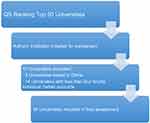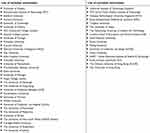Back to Journals » Advances in Medical Education and Practice » Volume 10
Who tweets in academia? An overview of Twitter use in higher education
Received 10 October 2018
Accepted for publication 7 February 2019
Published 8 April 2019 Volume 2019:10 Pages 171—174
DOI https://doi.org/10.2147/AMEP.S189963
Checked for plagiarism Yes
Review by Single anonymous peer review
Peer reviewer comments 2
Editor who approved publication: Dr Md Anwarul Azim Majumder
Dahn Jeong, Alireza Jalali
Department of Innovation in Medical Education, Office and Continuing Professional Development, Faculty of Medicine, University of Ottawa, Ottawa, ON, Canada
Abstract: Higher education institutions are increasingly using social media as a platform of communication with students, faculty, other institutions and the public. Based on the movement of most universities actively engaging in having a presence on social media, we were interested in analyzing which faculty or school, in the same university, has the most active followship online and generates the most social media impact.
Keywords: Twitter, social media, higher education
Our everyday lives are surrounded by social media tools. Social media has created new ways to communicate and interact with each other. A social media user can communicate with other individuals such as politicians or artists, or they can reach institutional users such as government agencies or schools. An individual can often find a wide audience with whom to communicate his or her views. Higher education institutions are increasingly using social media as a platform of communication with students, parents, faculty, other institutions and the public.1 In fact, a survey of 175 higher education institutions in the United States, Australia, Canada and New Zealand in 2008 showed that 10 years ago institutions already viewed participation in social media as no longer optional.2 Twitter, in particular, is of great interest in education,3,4 and its use has been increasing exponentially in the past few years.5 Briefly, Twitter is a social media platform where users can communicate through short messages (currently up to 280 characters) called “tweets”. Users can also “follow” other users on Twitter, which allows them to receive notifications of their tweets and generally indicates an interest in the information and messages communicated by the user of the followed account. In 2014, Times Higher Education published a ranking of universities based on their overall influence on Twitter.6 Other researchers looked at network models of “world-class” universities on Twitter7 and characterized the use of Twitter in Australian universities.8 Particularly, Palmer8 reported that in Australia, nearly all universities advertised a link to their Twitter accounts on their Internet home pages. Undoubtedly, Twitter is being employed as a popular communication service by higher education institutions around the world. Based on these findings and current trends of universities actively engaging in having a presence on Twitter, we were interested in seeing whether any differences or trends existed between the accounts of faculties in higher education institutions, rather than between institutions.
We looked at the top 50 universities according to the Quacquarelli Symonds’ (QS) “World University Rankings in 2018” and included all universities that had more than four faculties with Twitter accounts. Figure 1 shows the process of inclusion and exclusion of universities in this assessment. Universities in China were excluded due to the limited use of Twitter. Among the top 50 universities ranked by QS world rankings, 33 universities met our criteria. We have also included the institution where authors are based in for comparison. The list of included and excluded universities in this assessment is shown in Appendix 1. After establishing which universities to include, we searched Google, Twitter and individual university websites and faculty pages to look for schools and faculties Twitter accounts. The assessment revealed that 34 universities out of 50 had more than four schools or faculties with individual Twitter accounts. Then, among those 34 universities, we looked at the number of followers of each faculty’s Twitter account, in order to identify influential schools.9 For the purpose of this assessment, we classified these schools into eight categories: Faculty of Arts (includes Humanities and Journalism), Faculty of Law, Faculty of Education, Faculty of Health Sciences (includes Medicine, Dentistry, and Public Health), Faculty of Sciences, Faculty of Social Sciences, Faculty of Engineering and Faculty of Business (includes Management). Then, within each university, we compared which departmental faculty’s accounts had the most followers. Among the 34 universities we assessed, the type of faculty that most frequently had the highest number of Twitter followers was Faculty of Business (14 universities; 41.2%). The Faculties of Health Sciences had the highest number of followers in eight universities (23.5%). Faculties of Social Sciences and Engineering most often had the lowest number of followers; it is important to note that universities specialized as technological institutions (eg, California Institute of Technology, ETH Zurich, Ecole Polytechnique Fédérale de Lausanne (EPFL), etc.) were excluded from this assessment due to not meeting the inclusion criteria of having minimum four distinct faculties with Twitter account. Table 1 summarizes the frequencies of each faculty being the most followed faculty within their institution. Perhaps it is not surprising that in more than 40% of the universities business faculties had the highest number of followers, because Twitter is one of the most widely used social media tools in companies and business organizations.10 Because this assessment was based on the number of followers, we believe it may be insightful to further assess characteristics of the use of Twitter by different categories of faculty and investigate if any differences exist in these characteristics. Moreover, we briefly present the characteristics of each Faculty’s Twitter account from the authors’ institution to represent some of the aspects that could be further discussed and highlighted in future assessments in Table 2. With the exception of the Faculty of Engineering having the highest number of tweets, the Telfer School of Management’s Faculty of Business individual Twitter account had the highest number of followers with the most number of tweets and it was also one of first faculties at the University of Ottawa to have created an individual account. Some of additional questions to be answered are as follows: Who is managing the official Twitter account in different faculties? What kind of information is each faculty communicating? What are the characteristics of the followers? What seems to be the primary purpose of using Twitter for each faculty? Because the use of Twitter is still expanding in academia, these questions may bring insights into considering the scope and extent of social media’s use and impacts in education. The authors also plan to further investigate and address these questions and the findings will be reported in the future. We hope to encourage additional assessment and discussion around the use of Twitter in institutions of higher education and its impacts on education.
 | Table 1 Frequencies of each faculty’s Twitter account being the most followed within their institution (n=34) |
 | Table 2. Characteristics of each faculty’s Twitter account at the University of Ottawa |
 | Figure 1 Flowchart of included universities.Abbreviation: QS, Quacquarelli Symonds. |
Disclosure
The authors report no conflicts of interest in this work.
References
1. Sutherland S, Jalali A. Social media as an open-learning resource in medical education: current perspectives. Adv Med Educ Pract. 2017;8:369–375. doi:10.2147/AMEP.S112594
2. Reuben R. The Use of Social Media in Higher Education for Marketing and Communications: A Guide for Professionals in Higher Education; State University of New York at New Paltz. 2008. Availble from:
3. Dunlap JC, Lowenthal PR. Tweeting the night away: using Twitter to enhance social presence. J Inf Syst Educ. 2009;20:129–135.
4. Rinaldo SB, Tapp S, Laverie DA. Learning by tweeting: using Twitter as a pedagogical tool. J Mark Educ. 2011;33:193–203. doi:10.1177/0273475311410852
5. Jalali A, Sherbino J, Frank J, Sutherland S. Social media and medical education: exploring the potential of Twitter as a learning tool. Int Rev Psychiatry. 2015;27:140–146. doi:10.3109/09540261.2015.1015502
6. Parr C. Top 100 most influential UK and US universities on Twitter. Times High Educ (THE). May 16, 2014. Availble from:
7. Shields R. Following the leader? Network models of “world-class” universities on Twitter. High Educ. 2016;71:253–268. doi:10.1007/s10734-015-9900-z
8. Palmer S. Characterisation of the use of Twitter by Australian Universities. J High Educ Policy Manag. 2013;35:333–344. doi:10.1080/1360080X.2013.812029
9. Kwak H, Lee C, Park H, Moon S. What is Twitter, a social network or a news media?
10. Culnan MJ, McHugh P, Zubillaga I. How large U.S. companies can use Twitter and other social media to gain business value. MIS Q Exec. 2010;9:243–259.
 © 2019 The Author(s). This work is published and licensed by Dove Medical Press Limited. The full terms of this license are available at https://www.dovepress.com/terms.php and incorporate the Creative Commons Attribution - Non Commercial (unported, v3.0) License.
By accessing the work you hereby accept the Terms. Non-commercial uses of the work are permitted without any further permission from Dove Medical Press Limited, provided the work is properly attributed. For permission for commercial use of this work, please see paragraphs 4.2 and 5 of our Terms.
© 2019 The Author(s). This work is published and licensed by Dove Medical Press Limited. The full terms of this license are available at https://www.dovepress.com/terms.php and incorporate the Creative Commons Attribution - Non Commercial (unported, v3.0) License.
By accessing the work you hereby accept the Terms. Non-commercial uses of the work are permitted without any further permission from Dove Medical Press Limited, provided the work is properly attributed. For permission for commercial use of this work, please see paragraphs 4.2 and 5 of our Terms.

